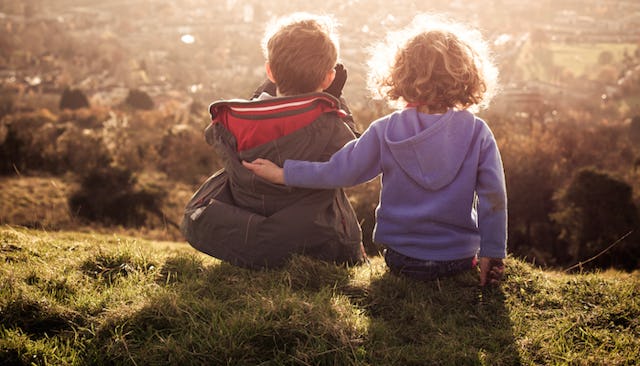Empathy Education Is A Thing, And It Is Vital For Our Children

It’s critical for young children to learn about reading, writing, math, and science, no doubt. However, educators are beginning to see a correlation between a student’s own emotional well-being and their ability to thrive in school. This becomes particularly apparent when a child is struggling with social problems like poverty, unsafe neighborhoods, violence, and family trauma.
Schools can’t necessarily fix all of these social and family problems for their students, but they can assist them in developing the emotional skills necessary to process their struggles so they are able to focus and flourish in the classroom.
Of course, grade-school educators are not social workers, counselors, or therapists (they have far more than enough on their plate), but it is easy to argue that they wear a lot of hats. And now some schools are starting to take the idea of emotional intelligence seriously and integrate emotional education into their curriculum, particularly empathy education. But the question many educators struggle with is, “How do you teach something as unquantifiable as empathy?”
Katrina Schwartz of KQED News explains how one school is answering that very question: “Oakland Unified School District, for example, is piloting a program called Roots of Empathy in 20 schools across the district. The program teaches students how to be empathetic by bringing a baby and the baby’s parent into K-12 classrooms. The students are asked to think about the baby’s experience as it explores the classroom, while a trained facilitator helps them name the baby’s feelings and emotions. Focusing on the baby and its vulnerability allows students to practice empathy, making it easier to identify their own emotions in the future. As they become more self-aware they’re better able to develop respectful and caring relationships.”
While this sounds easy enough, it’s important to realize that these programs are teaching empathy, not sympathy. Oftentimes, these two terms are used interchangeably, but there is, in fact, a huge difference. In a TED-Ed Selects short video, Brené Brown, a research professor at the University of Houston Graduate College of Social Work, explains the difference between empathy and sympathy: “Empathy fuels connection. Sympathy drives disconnection. […] Empathy is feeling with people.”
In a world that is often described as “me, me, me,” learning how to feel empathy for other people is a powerful tool. When children are taught empathy, they learn how to better understand their own emotions while also tuning in to the emotions of others, and ultimately, they learn how to work with others when faced with challenges.
Through empathy education, children learn to find connection. They gain the power to look at another person and understand their emotions and the motivations for their behaviors. This teaches children to respond to other people on a personal level, to give someone the benefit of the doubt. It helps our children better understand the world outside of themselves, and ultimately, it teaches them to be better humans.
Furthermore, learning about empathy helps children feel more comfortable talking about emotions in general and leads to less acting out. In fact, Tony Smith, superintendent of Oakland Unified School District told KQED News that “many of our young people don’t have the capacity to struggle productively with other people around their ideas and not shut down if they’re feeling uncomfortable.” They also found that emotional literacy creates a framework for emotional comfort, so that when working with others, children don’t shut down when they are feeling uncomfortable.
As a child who was raised in a broken home, I can say firsthand that I’d have appreciated empathy education when I was attending school, particularly while grappling to understand my parents divorce and my father’s later incarceration. I never saw a therapist until I was in my 20s, and most of our sessions were spent with him digging around, asking questions, and me having no language to explain the emotions I’d been struggling with up until that time.
And as a father of three, I can see how empathy education would help my own children. My son is 9, and while he doesn’t face the family struggles that I had, it’s clear that he has a difficult time understanding his own emotions, let alone the emotions of others. He shuts down whenever someone asks him how he feels. Often, he’ll break down and cry when faced with a problem, then run to his room embarrassed, and refuse to talk about it. This is not unusual behavior for a boy his age, but I’d love to help him learn how to manage situations like this now, so he can process his emotions in a healthier way in the future.
Ultimately, empathy education has the potential to teach our children how to better understand themselves and others. It will give them the knowledge and tools to navigate their own emotional landscape. And it will grant them the confidence to speak up when they feel like something is amiss in their world. This carries huge socio-emotional benefits for students, their peers, and their community at large.
It’s a new idea, naturally, but it’s an important one that I’d love to see further developed. I think we can all agree that learning to dig deeper and connect with others is a vital part of making this country and our world great.
This article was originally published on